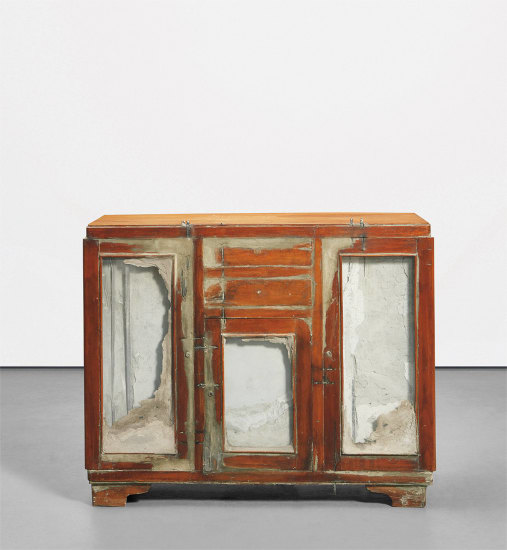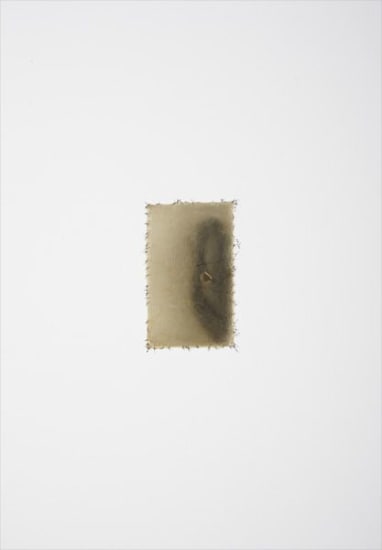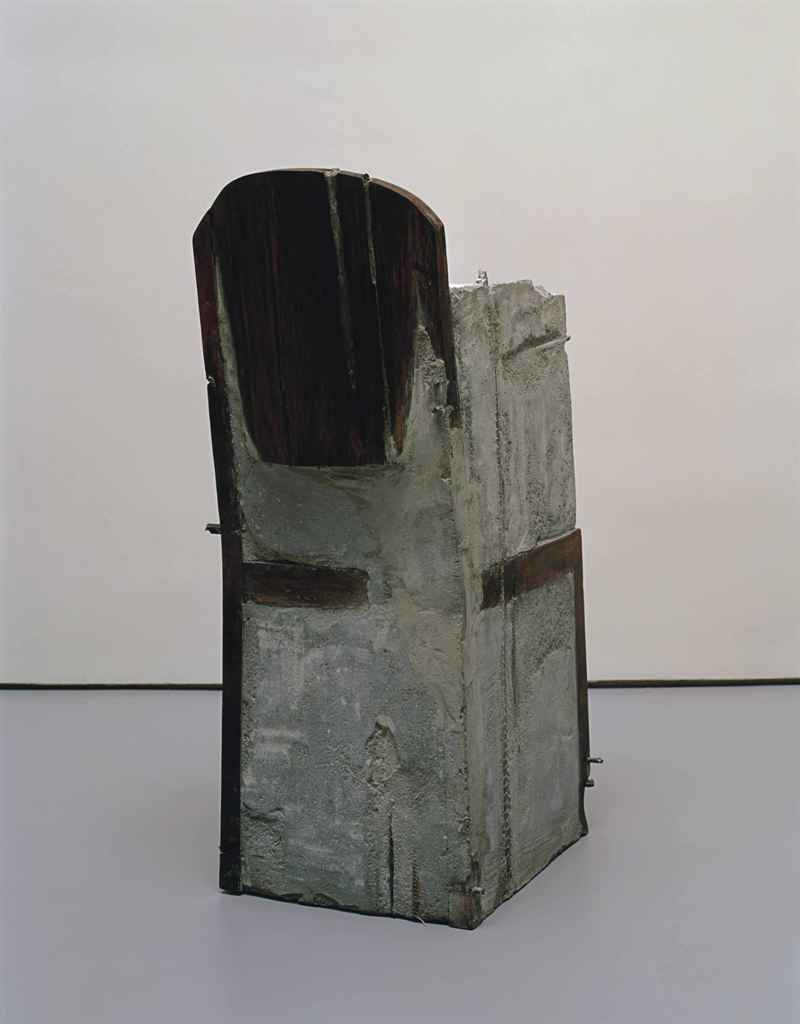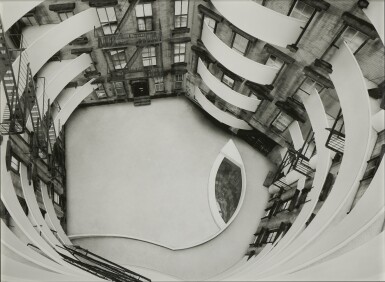Doris Salcedo Untitled 1992 wood, cement, wire mesh and steel 60 1/4 x 36 1/2 x 16 in. (153 x 92.7 x 40.6 cm)
Provenance Alexander and Bonin, New York Private Collection, Baltimore Christie’s, London, Post-War and Contemporary Art, June 23, 2005, Lot 54 Acquired from the above sale by the present owner Exhibited Pittsburgh, Carnegie Museum of Art, Carnegie International, 1995 Literature C. Basualdo, A. Huyssen, N. Princenthal, ed., Doris Salcedo New York: Phaidon, 2000, p. 28 and p. 114 (illustrated) Phillips is grateful to Carolyn Alexander for her kind assistance cataloguing this work. Video Doris Salcedo - Untitled, 1992 Henry Allsop, Worldwide Head of Latin American Art, discusses Doris Salcedo's important untitled sculpture from 1992, a beautiful example of the artist’s ability to tell the story of the victims of Colombia’s history of political violence. Catalogue Essay Doris Salcedo’s sculptures and installations inform us about some of the most distressing aspects of human society. The pain, trauma, and loss associated with political violence, systemic inequality, and war consistently find their way into her work. Rather than an aesthetic exercise which seeks to provide answers, Salcedo’s works offer us a space for reflection and critical engagement. They constantly remind us of the paradoxes reflected by the scars of violent conflicts and how the unimaginable suffering becomes unexpectedly real. Her installations, for the most part, consist of every-day objects such as chairs, tables, beds, armoires, and clothing that relate in some way to victims’ stories. These objects are not only evidence of the plight of victims and of the brutality of violence, but of those who are left behind to endure the pain and suffering of loss. These pieces of furniture are thus contemplative objects that allow viewers to become conscious of the lives of victims, the displacement, and separation of families that become inherent parts of violent conflicts. Using a found cabinet, the present lot,Untitled, 1992, is a beautiful example of Salcedo’s ability to tell the story of the victims of Colombia’s history of political violence. Salcedo’s craft lies not in recreating the tragedy, but in assembling the pieces so that the loss and pain “remains forever a presence in the present moment” (N. Princenthal, C. Basualdo, A. Huyssen, Doris Salcedo 2000, p.10). In this way, she is giving form to the “community” or “society” of victims of violence. The artist asserts that the reality of political violence in Colombia is intrusive as it disrupts the way you wish to live and thus imposes an awareness of the other’s suffering. According to the artist, she is able to articulate this awareness by feeling as an outsider in her own country. It is at this distance that she is able to maintain a critical position on the society she belongs to. Untitled, 1992, is an iconic example of the way in which Salcedo emulates an aesthetic of disappearance in other important sculptures. Salcedo accomplishes this by including first-hand evidence from real victims of war in Colombia. As in her other works, the bodies of victims are never revealed. Rather they are imagined through the traces of discarded clothing they have left on abandoned domestic furniture; much like this abandoned cabinet that once belonged to a victim. The clothing and the furniture have the effect of alerting us to how profoundly human these materials are. Salcedo explains that when a loved one disappears, everything is saturated with that person’s presence. Not only are the objects reminders of that absence but, in fact, they begin to overshadow the presence. The imperfections and wear—traces of their previous life as domestic objects—make the absence of the original owner obvious, causing the viewer to ponder this person’s fate. The chest’s cavities, as in all the other furniture in this series, have been filled with concrete, alluding to a form of preservation where even the weight of the concrete is commensurate to the emotional weight implied in these disappearances. Salcedo’s sculpture informs us of
Doris Salcedo Untitled 1992 wood, cement, wire mesh and steel 60 1/4 x 36 1/2 x 16 in. (153 x 92.7 x 40.6 cm)
Provenance Alexander and Bonin, New York Private Collection, Baltimore Christie’s, London, Post-War and Contemporary Art, June 23, 2005, Lot 54 Acquired from the above sale by the present owner Exhibited Pittsburgh, Carnegie Museum of Art, Carnegie International, 1995 Literature C. Basualdo, A. Huyssen, N. Princenthal, ed., Doris Salcedo New York: Phaidon, 2000, p. 28 and p. 114 (illustrated) Phillips is grateful to Carolyn Alexander for her kind assistance cataloguing this work. Video Doris Salcedo - Untitled, 1992 Henry Allsop, Worldwide Head of Latin American Art, discusses Doris Salcedo's important untitled sculpture from 1992, a beautiful example of the artist’s ability to tell the story of the victims of Colombia’s history of political violence. Catalogue Essay Doris Salcedo’s sculptures and installations inform us about some of the most distressing aspects of human society. The pain, trauma, and loss associated with political violence, systemic inequality, and war consistently find their way into her work. Rather than an aesthetic exercise which seeks to provide answers, Salcedo’s works offer us a space for reflection and critical engagement. They constantly remind us of the paradoxes reflected by the scars of violent conflicts and how the unimaginable suffering becomes unexpectedly real. Her installations, for the most part, consist of every-day objects such as chairs, tables, beds, armoires, and clothing that relate in some way to victims’ stories. These objects are not only evidence of the plight of victims and of the brutality of violence, but of those who are left behind to endure the pain and suffering of loss. These pieces of furniture are thus contemplative objects that allow viewers to become conscious of the lives of victims, the displacement, and separation of families that become inherent parts of violent conflicts. Using a found cabinet, the present lot,Untitled, 1992, is a beautiful example of Salcedo’s ability to tell the story of the victims of Colombia’s history of political violence. Salcedo’s craft lies not in recreating the tragedy, but in assembling the pieces so that the loss and pain “remains forever a presence in the present moment” (N. Princenthal, C. Basualdo, A. Huyssen, Doris Salcedo 2000, p.10). In this way, she is giving form to the “community” or “society” of victims of violence. The artist asserts that the reality of political violence in Colombia is intrusive as it disrupts the way you wish to live and thus imposes an awareness of the other’s suffering. According to the artist, she is able to articulate this awareness by feeling as an outsider in her own country. It is at this distance that she is able to maintain a critical position on the society she belongs to. Untitled, 1992, is an iconic example of the way in which Salcedo emulates an aesthetic of disappearance in other important sculptures. Salcedo accomplishes this by including first-hand evidence from real victims of war in Colombia. As in her other works, the bodies of victims are never revealed. Rather they are imagined through the traces of discarded clothing they have left on abandoned domestic furniture; much like this abandoned cabinet that once belonged to a victim. The clothing and the furniture have the effect of alerting us to how profoundly human these materials are. Salcedo explains that when a loved one disappears, everything is saturated with that person’s presence. Not only are the objects reminders of that absence but, in fact, they begin to overshadow the presence. The imperfections and wear—traces of their previous life as domestic objects—make the absence of the original owner obvious, causing the viewer to ponder this person’s fate. The chest’s cavities, as in all the other furniture in this series, have been filled with concrete, alluding to a form of preservation where even the weight of the concrete is commensurate to the emotional weight implied in these disappearances. Salcedo’s sculpture informs us of












Try LotSearch and its premium features for 7 days - without any costs!
Be notified automatically about new items in upcoming auctions.
Create an alert